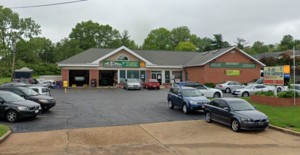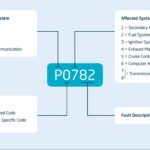The dreaded check engine light can illuminate for various reasons, leaving drivers puzzled and concerned. One common culprit is the EOBD/OBDII error code P2121. This code signifies a problem within the vehicle’s electronic throttle control system, specifically with the “Throttle/Pedal Position Sensor/Switch “D” Circuit.” Understanding this code is crucial for effective diagnosis and repair. This article will delve into the intricacies of the P2121 code, outlining its causes, symptoms, and common solutions.
What Does the P2121 Code Mean?
Modern vehicles utilize an electronic throttle control system (ETCS) to regulate engine speed and power output. The ETCS relies on several components, including the accelerator pedal position (APP) sensor, throttle body, and the powertrain control module (PCM). The APP sensor, also known as the throttle position sensor, measures the position of the accelerator pedal and transmits this information to the PCM. The PCM then uses this data to adjust the throttle plate opening, controlling the amount of air entering the engine.
The P2121 code indicates that the PCM has detected an issue with the “D” circuit of the APP sensor. This could mean a faulty sensor, a wiring problem within the circuit, or even a malfunctioning PCM. Essentially, the PCM is not receiving the correct signal from the APP sensor, hindering its ability to control the engine’s throttle effectively. This can lead to various drivability problems and reduced engine performance.
Symptoms of a P2121 Code
When the P2121 code is triggered, drivers may experience several symptoms, including:
- Decreased Engine Performance: The engine may feel sluggish or lack power, especially during acceleration.
- Limp Home Mode: In some cases, the PCM may activate a “limp home mode” to prevent further damage. This mode severely limits engine power, allowing the driver to reach a repair shop safely. The check engine light will likely be flashing in this scenario.
- Erratic Idle: The engine may idle rough or stall unexpectedly.
- Check Engine Light Illumination: The most obvious symptom is the illumination of the check engine light on the dashboard.
Common Causes of the P2121 Code
Several issues can trigger the P2121 code:
- Faulty APP Sensor: A malfunctioning APP sensor is the most common cause. This sensor can wear out over time or become damaged due to exposure to moisture or debris.
- Wiring Problems: Damaged or corroded wiring within the APP sensor circuit can disrupt the signal transmission, leading to the P2121 code.
- Throttle Body Issues: Problems with the throttle body itself, such as a stuck or malfunctioning throttle plate, can also contribute to this code.
- PCM Malfunction: In rare cases, a faulty PCM can be the root cause. However, other possibilities should be thoroughly investigated before suspecting the PCM.
Diagnosing and Fixing the P2121 Code
Diagnosing the P2121 code requires specialized diagnostic tools, such as an OBDII scanner, to retrieve the code and pinpoint the problem area. A qualified mechanic will typically perform the following steps:
- Retrieve the Code: Using an OBDII scanner, confirm the presence of the P2121 code.
- Inspect the APP Sensor: Visually inspect the APP sensor for signs of damage or corrosion. Test the sensor’s voltage and resistance using a multimeter to ensure it’s operating within specifications.
- Check Wiring and Connectors: Thoroughly inspect the wiring harness and connectors for any damage, loose connections, or corrosion.
- Test the Throttle Body: Inspect and test the throttle body for proper operation.
- Diagnose the PCM: If all other components check out, the PCM may need further diagnosis or replacement.
Conclusion
The EOBD/OBDII error code P2121 indicates a problem within the electronic throttle control system, potentially affecting drivability and engine performance. By understanding the causes, symptoms, and diagnostic procedures associated with this code, drivers can take the necessary steps to address the issue promptly and ensure their vehicle’s safe and efficient operation. Consulting a qualified mechanic with diagnostic expertise is crucial for accurate diagnosis and repair.


